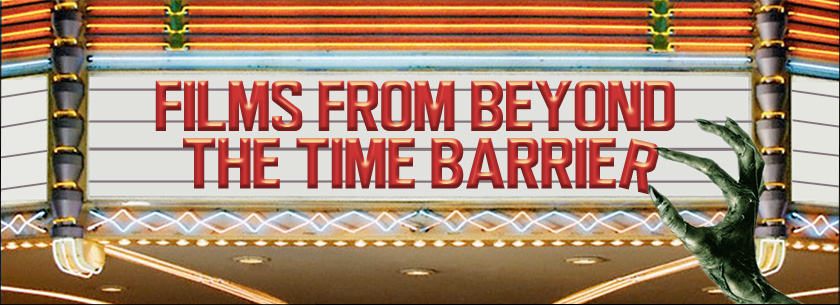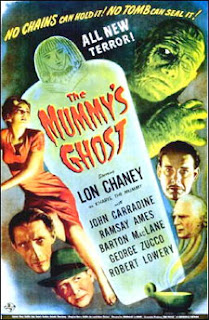 |
| HAlloween MoVie Rating: Monsters created by Ashton are not for the squeamish |
Some years after Jack Pierce performed his last bit of wizardry for Universal, another extremely talented makeup artist and monster-maker extraordinaire appeared on the horror movie scene -- in the UK. Working strictly freelance, Roy Ashton helped Hammer Studios re-conceptualize and revitalize the look of all of the classic monsters. In addition, he added more than a few terrifying creations of his own. Like Pierce and his iconic creations, it's hard to imagine Hammer's horror renaissance without the ghastly visages that sprang from the mind of this modest, unassuming artist.
 |
| Master Monster Maker Roy Ashton |
I had seen the name Roy Ashton in Hammer credits and in a handful of film magazine articles, but I only recently became fully aware of the man's contributions to Hammer horror iconography. A couple of years ago I was browsing one of my favorite used bookstores when I stumbled across an intriguing trade paperback, Greasepaint and Gore: The Hammer Monsters of Roy Ashton (Bruce Sachs and Russell Wall, Tomahawk Press, Sheffield, England, 1998). It was packed with production stills and drawings and all kinds of behind-the-scenes information from Hammer's golden era. I was hooked. One man's trade-in became my treasure.
I was amazed to find out just how many of the unforgettable creatures and frightful faces from Hammer films were the work of this one very talented man. The authors have very meticulously and lovingly documented Ashton's Hammer years through interviews, photos, and many of Ashton's original drawings. It's a fascinating account of a near-genius artist-craftsman working for one of the great, innovative film studios.
So, here's a suggestion for a Halloween night Hammer movie marathon featuring Roy Ashton's best, most terrifying creations (and as an added bonus, makeup "tips" from Greasepaint and Gore):
#4: The Mummy (1959)
After the successes of The Curse of Frankenstein (1957) and Horror of Dracula (1958), Hammer secured the rights to Universal's entire horror catalog. The Mummy was Hammer's third pairing of Cushing and Lee (why mess with success?). All of the familiar Universal characters and themes are in Hammer's re-make: the unearthing of Princess Ananka's tomb; an Egyptian fanatic determined to make the infidels pay for the desecrations; the resurrection of Kharis, Ananka's ill-fated lover; a modern woman who is the living image of Ananka, etc. In addition to giving the Mummy a much more intimidating physical presence, Lee -- in spite of makeup that obscured most of his features -- also managed to convey the sadness and tragedy of poor Kharis. You feel sorry for him even as he relentlessly mows down the tomb defilers.
Makeup Tip: Ashton made several trips to the British Museum to research mummies and mummification for the production. There was an actual mummy on display there, and he was able to examine it thoroughly and make numerous sketches. Christopher Lee remembered dealing with the final product: "It was very difficult wearing those bandages… I couldn't get out of them once they were on me. It would take too long to get out and get back in. …" Roy came up with a kind of tunic with a zipper in the back that was easier to work with. The zipper was then concealed with wrappings that went over the shoulder and around the back. (Sachs and Wall, Greasepaint and Gore, Tomahawk Press, 1998)
The Mummy is available on DVD from Warner Home Video.
#3: The Curse of the Werewolf (1961)
For Hammer's one foray into lycanthropy, the studio decided to dispense with Universal's story and character and draw fresh inspiration from Guy Endore's 1933 novel, The Werewolf of Paris. Rather than the relatively contemporary setting of The Wolf Man (1940), Curse is set in 18th century Spain, where a cruel and capricious nobleman invites a penniless beggar into his house during his wedding party, then gets him drunk and humiliates him before mercilessly consigning him to the dungeon for life. Years later, when a housemaid resists the advances of the decadent old nobleman, she's thrown into the same dungeon with the now haggard, bestial, and mindless beggar. She is raped, and before dying, bears a child (Oliver Reed) who grows up to be handsome and vigorous and animalistic -- especially when the moon is bright.
Makeup Tip: I remember as a kid being deeply impressed with the werewolf in this one (okay, maybe scared is a better word). This is the creation that Ashton himself was most proud of. Among other things, he made use of walnuts and candles to create the fearsome makeup: "I made an appliance which fitted underneath his (Reed's) eyes and went right over the top of his head and over the ears. I pushed out his nostrils with a pair of candles. I used walnuts first of all. You cut a walnut in half, punch a hole through the shell, and stick it up the nostril. It's a bit uncomfortable. But if you take a candle and draw the wick out of it, then that leaves you with a sort of hollow cylinder. I cut sections off of that and stick them up the actor's nose and the warmth of the nose adjusts the shape of the candle to the shape of the nostrils. Then you can breathe easily…" (Ibid.)
The Curse of the Werewolf is available on The Hammer Horror Series DVD set.
#2: The Plague of the Zombies (1966)
In a remote Cornish village, someone is solving the local labor shortage with strange Voodoo rituals. For a full review, see my post at Mr Movie Fiend.
Makeup Tip: Ashton's effective makeup for the Voodoo-created zombies in Plague provided a terrifying template for George Romero and all the stumbling creatures that followed in the wake of Night of the Living Dead (1968). Here's his advice for creating animated corpses on a low budget: "Rotting skins can be suggested through a mixture of rubber and paper, then a careful application of cosmetics. By crumpling up tissue paper, coloring it with Fuller's earth and then covering it with liquid latex, one can create a very effective specimen. Areas on the face on which to demonstrate crumbling scabs or splitting skins include: the forehead, the bridge of the nose, or chin as natural starting points. I would suggest building up an excess of material and then shred the latex slightly by gentle tearing." (Ibid.)
The Plague of the Zombies is available on DVD from Anchor Bay.
#1: The Reptile (1966)
The Reptile was filmed back-to-back with Plague of the Zombies using many of the same sets and crew members. The setting again is a small country village. Harry and Valerie Spalding (Ray Barrett and Jennifer Daniel) move into the family cottage when Harry's brother mysteriously dies. They receive a chilly reception from the villagers, who are terrified by a mysterious, venomous thing that seems to strike at will and turns the skin of its victims grotesquely black. An eccentric neighbor, Dr. Franklyn (Noel Willman), and his beautiful but tormented daughter Anna (Jacqueline Pearce), seem to hold the key to the dark, murderous secret.
Makeup Tip: The Reptile was Ashton's last credited triumph for Hammer -- the uncertain nature of his freelance status, the short timeframes, low budgets and low pay finally motivated Roy to say goodbye to the studio. Many think he saved his best work for last. The Reptile is a truly frightening, repugnant female monster, and a fitting finish for the Halloween movie marathon countdown. Typically, Ashton did his homework: "A lot of research went into the appearance of the Reptile. Again I consulted anatomical authorities, drew snakes many times and constructed a model adapting the plate-like build-up of reptilian scales to the bones of the human head. There is a clear similarity of the human head to the structure of a snake's skull. … To suggest the scales I took a discarded Boa Constrictor's skin and made a female cast of this in plaster. Into this I poured plastic and upon curing it gave me a perfect snake skin material with all the marvelous patterning intact. Sections of this I fitted wherever was appropriate in the head, the cheeks, the neck and so on, until the results took on a serpent-like appearance." (Ibid.)
The Reptile is available on DVD from Anchor Bay.



























